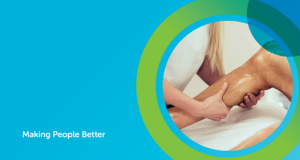Share
With the new football season just around the corner, for some pre-season might be under your belts and you are raring to go for the season opener. For others you may have been motivated to give football a go for the first time as you aspire to be the next Chloe Kelly. This post will be beneficial for the old and the new to the game as we will focus on the three most common injuries, starting with ankle sprains, knee injuries and lastly muscular strains. Starting with a bit of learning behind each and then moving on to injury prevention tips and what to do if you have suffered from one of these injuries.
Ankle Sprains
I am sure most people reading this will have rolled their ankle in the past and know the pain and annoyance that goes with it. Due to the fast-paced nature of football, ankles sprains are likely to occur due to a sudden change in direction in which the ankle may give in or roll, or it can occur as a result of a strong challenge. Due to the design of our ankles the foot is more likely to roll inwards and therefore we are more likely to damage or stretch the ligaments on the outside of the ankle. There are three ligaments which help to support the outer aspect of our ankle and working from front to back they are named the anterior talofibular ligament (ATFL), the calcaneofibular ligament (CFL) and lastly the posterior talofibular ligament (PTFL). Out of these three, the ATFL is the most common ligament to suffer from a sprain. Usually for the recovery time you are looking at about a 4–6-week period for the ligament to heel and return to football however, this does vary depending on the severity of the strain. Due to the nature of ankle sprains without a good rest and rehabilitation structure in place there is a high chance of re-injury.
Knee injuries
When it comes to knee injuries in football, it is commonly referred to as “the big three”. There are three main structures which make up the bulk of injuries from football and they are mostly damaged during a bad tackle or from a sudden change of direction in which your knee just wasn’t in the right position. These structures are the medial collateral ligament (MCL), the meniscus and lastly but not least the anterior cruciate ligament (ACL).
The MCL is located on the inside of the knee and connects the femur (upper leg) to the tibia (lower leg). The main role of the MCL is to prevent any side-to-side movement in the knee joint. This ligament is most commonly injured during a tackle in which your knee has been forced inwards, putting strain on the MCL.
The meniscus are two crescent shaped structures that sit between the tibia and the femur. The main role of the meniscus is to act as shock absorbers for the knee, increase stability and provides the knee with lubrication and nutrition. In football this is most likely to be damaged during a twisting motion in the knee, so could be from a challenge or could be from a sudden change of direction usually when the knee is already fully flexed and then twisted. Depending on the severity of the tear to the meniscus it could cause the knee to lock or cause instability.
Lastly the ACL which plays a crucial role in preventing the tibia from moving too far forward of the femur bone. Again, the ACL is usually damaged or even ruptured during a tackle but can occur while running or changing direction. For a full rupture, usually the player will be able to feel or even hear a popping sound in the knee. In the coming days on top of pain you may feel instability in the knee and have limited range of movement. Out of the three this is usually the most severe injury and could require an operation to fox, however, recently there have been a number of studies finding that the ACL can recover without surgery, It is therefore important to discuss your goals with your Physio or consultant so that the best path and correct goals and timelines can be set.
Muscular strains
As with any sport that requires constant change of speeds and direction over a long period, muscle injuries are going to occur. In football the most commonly injured muscles are your hamstrings, quadriceps and groin muscles however, it is possible to strain almost any muscle in your body. Your hamstrings and quadriceps are involved heavily while running, therefore strains are common especially as the game goes on and you become increasingly tired, therefore your muscle is fatiguing and then one overexertion or one quick change of speed to sprint may be what causes the strain. Similarly with your groin muscles, due to kicking the ball and using these muscles constantly throughout the game, one kick may cause a strain in the inner thigh.
Depending on the level of strain, the muscles can even tear, in which case usually a popping sensation is felt in the muscle and you may have bruising and inflammation appear around the area.
Injury Prevention
One of the biggest things to do to help prevent injury is to do a thorough warm up before the game starts and a good cool down post game. During the warm up, it should last at least 10 minutes and you want to try and target all major muscle groups that you will be using. For football it will be largely leg based however it is also important to warm up your upper body as well. You should start with some light stretches then build up starting with light exercises and drills such as some ladder work or jogging to get the muscles going. You should then gradually build up intensity into a game like structure.
Another big aspect of injury prevention is strength and conditioning outside of your matches. A lot of higher-level teams on top of their regular training will also do strength training twice a week. The stronger we can get your bigger muscles, the less likely they are going to be strain and the more support they will offer your joints while playing football. If you don’t have access to a gym, then general bodyweight exercises such as heel raises, squats, lunges and bridging can be used to help build muscle in the main lower limb muscle groups.
It is also important to practice your balance, just like a muscle your balance is something that can decrease over time if not used and challenged. To make it functional to football, the best way to do this will be to stand on one leg and kick a ball against the wall or get a partner to challenge you and keep you guessing. Lastly to increase your agility and ability to change direction using ladder exercises or hopping.
To help with the pressure on the joints, if you have put on a little bit of weight during the off season (don’t worry we have all been there), then trying to lose some of that weight before starting regular games is a massive way to help prevent injuries.
What to do in case of injury
If you are reading this post as you have already suffered from any of the above and you are looking for advice as to what to do next. The best thing to do for any of the above for the first week at least will be to rest the joint or muscle as much as possible. Ice the joint or muscle daily in blocks of 20 minutes, be sure to put your ice or frozen peas in a damp tea towel to avoid any frostbite. Keep the leg elevated and apply compression bandages at times throughout the day. However it’s always important to make sure that you don’t sleep with the compression bandage on. Once the symptoms have settled down is when you can start to build up muscle strength and really start your rehabilitation.
As with any aches and pains, if you have suffered from any of the above, we at Vita would be happy to get you back to football as quickly and as safely as possible.
Related News
Vita is an award-winning, CQC registered healthcare provider














